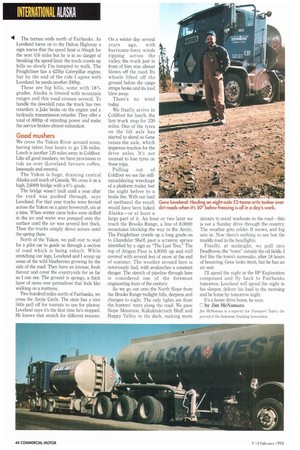INTERNATIONAL ALASKA 4 1 The tarmac ends north of Fairbanks. As
Page 48

If you've noticed an error in this article please click here to report it so we can fix it.
Loveland turns on to the Dalton Highway a sign warns that the speed limit is 50mph for the next 416 miles but he is in no danger of breaking the speed limit: the truck crawls up hills so slowly Fm tempted to walk. The Freightliner has a 425hp Caterpillar engine, but by the end of the ride I agree with Loveland: he needs another 200hp.
These are big hills, some with 18% grades. Alaska is littered with mountain ranges and this road crosses several. To handle the downhill runs the truck has two retarders: a Jake brake on the engine and a hydraulic transmission retarder. They offer a total of 800hp of retarding power and make the service brakes almost redundant.
Good mushers
We cross the Yukon River around noon, having taken four hours to go 136 miles. Lunch is another 120 miles away in Coldfoot. Like all good mushers, we have provisions to tide us over (Loveland favours coffee, lemonade and sweets).
The Yukon is huge, draining central Alaska and much of Canada. We cross it on a high, 2,600ft bridge with a 6% grade.
The bridge wasn't built until a year after the road was pushed through, says Loveland. For that year trucks were ferried across the Yukon on a giant hovercraft, six at a time. When winter came holes were drilled in the ice and water was pumped onto the surface until the ice was several feet thick. Then the trucks simply drove across until the spring thaw.
North of the Yukon, we pull over to wait for a pilot car to guide us through a section of road which is being rebuilt. While stretching our legs, Loveland and I scoop up some of the wild blueberries growing by the side of the road. They have an intense, fresh flavour and cover the countryside for as far as I can see. The ground is spongy, a thick layer of moss over permafrost that feels like walking on a mattress.
Two hundred miles north of Fairbanks, we cross the Arctic Circle. The state has a nice little pull off for tourists to use for photos; Loveland says it's the first time he's stopped. He knows that stretch for different reasons. On a winter day several years ago, with hurricane-force winds ripping across the valley, the truck just in front of him was almost blown off the road. Its wheels lifted off the ground before the cargo straps broke and its load blew away.
There's no wind today.
We finally arrive in Coldfoot for lunch, the last truck stop for 230 miles. One of the tyres on the lift axle has started to shred so Gene raises the axle, which improves traction for tilt, drive axles. It's nor unusual to lose tyres on these trips.
Pulling out of Coldfoot we see the stillsmouldering wreckage of a platform trailer, lost the night before to a brake fire. With our load of methanol the result would have been baked Alaska—or at least a large part of it. An hour or two later we reach the Brooks Range, a line of 8,000ft mountains blocking the way to the Arctic. The Freightliner crawls up a long grade on to Chandalar Shelf, past a scrawny spruce identified by a sign as "The Last Tree." The top of Atigun Pass is 4,800ft up and still covered with several feet of snow at the end of summer. The weather around here is notoriously bad, with avalanches a constant danger. The stretch of pipeline through here is considered one of the foremost engineering feats of the century.
As we go out onto the North Slope from the Brooks Range twilight falls, deepens and changes to night. The only lights are from the hunters' tents along the road. We pass Slope Mountain, Kakuktukruich Bluff and Happy Valley in the dark, making more detours to avoid washouts in the road—this is not a Sunday drive through the country. The weather gets colder. It snows, and fog sets in. Now there's nothing to see but the muddy road in the headlights.
Finally, at midnight, we pull into Deadhorse, the "town" outside the oil fields. 1 feel like the town's namesake, after 18 hours of bouncing; Gene looks fresh, but he has an air seat.
I'll spend the night at the BP Exploration compound and fly back to Fairbanks tomorrow. Loveland will spend the night in his sleeper, deliver his load in the morning and be home by tomorrow night.
It's a faster drive home, he says.
171 by Jim McNamara
Jim McNamara is a reporter for Transport Topics, the journal of the American Trucking Association.


































































































